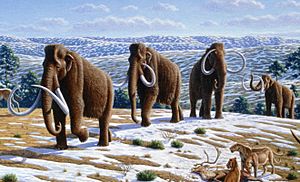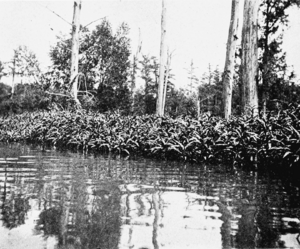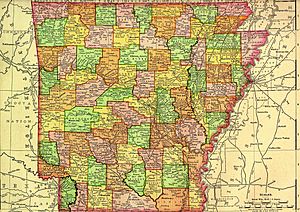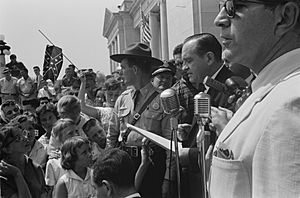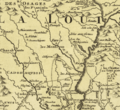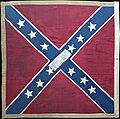History of Arkansas facts for kids
The history of Arkansas began millennia ago when humans first crossed into North America. Many tribes used Arkansas as their hunting lands but the main tribe was the Quapaw, who settled in the Arkansas River delta upon moving south from Illinois. Early French explorers gave the territory its name, a corruption of Akansea, which is a phonetic spelling from the Illinois language word for the Quapaw. This phonetic heritage explains why "Arkansas" is pronounced so differently than the U.S. state of "Kansas" even though they share the same spelling.
What began as a rough wilderness inhabited by trappers and hunters became incorporated into the United States as part of the Louisiana Purchase in 1803 and later became the Arkansas Territory from 1819–1836. Upon gaining statehood on June 15, 1836, Arkansas had begun to prosper under a plantation economy that was heavily reliant on slave labor. After the American Civil War (1861–1865), Arkansas was a poor rural state, whose main economic base revolved around agriculture based chiefly on cotton production. In the late 19th century, the state instituted various Jim Crow laws to disenfranchise and segregate the African American population. This would last until federal legislation was passed in the 1960s. During the civil rights movement of the 1950s and 1960s, Arkansas and particularly Little Rock, were major battlegrounds for efforts to integrate schools.
The state started to see some economic prosperity during and after World War II in the 1940s. Arkansas became the base for retail corporation Walmart during the 1960s, which is headquartered in Bentonville. Walmart would later become the world's largest company by revenue. During the 20th century, different Arkansas political leaders would become nationally prominent, including the 42nd U.S. President Bill Clinton, who was Governor of Arkansas, 1979–81 and 1983–92.
Contents
Early Arkansas
Archaic and Paleo periods
Beginning around 11700 B.C.E., the first indigenous people inhabited the area now known as Arkansas after crossing today's Bering Strait, formerly Beringia.
The first people in modern-day Arkansas likely hunted woolly mammoths by running them off cliffs or using Clovis points, and began to fish as major rivers began to thaw towards the end of the last great ice age.
Forests also began to grow around 9500 BCE, allowing for more gathering by native peoples. Crude containers became a necessity for storing gathered items. Since mammoths had become extinct, hunting bison and deer became more common. These early peoples of Arkansas likely lived in base camps and departed on hunting trips for months at a time.
Woodland and Mississippi periods
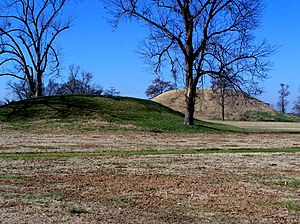
Further warming led to the beginnings of agriculture in Arkansas around 650 BCE. Fields consisted of clearings, and Native Americans would begin to form villages around the plot of trees they had cleared.
The Native American nations that lived in Arkansas prior to the westward movement of peoples from the East were the Quapaw, Caddo, and Osage Nations. While moving westward, the Five Civilized Tribes inhabited Arkansas during its territorial period.
European Exploration
The first European to reach Arkansas was the Spanish explorer Hernando de Soto in the middle of the 16th century. Arkansas is one of several U.S. states formed from the territory purchased from Napoleon Bonaparte in the Louisiana Purchase. The early Spanish or French explorers of the state gave it its name, probably a phonetic spelling of the Illinois word for the Quapaw people, who lived downriver from them.
The first European settlement in Arkansas was Arkansas Post, established in 1686 by Henri De Tonti. The post disbanded for unknown reasons in 1699 but was reestablished in 1721 in the same location. Located slightly upriver from the confluence of the Arkansas River and Mississippi River, the remote post was a center of trade and home base for fur trappers in the region to trade their wares.
Early 19th century territory and statehood
The region is organized as the Territory of Arkansas on July 4, 1819, but the territory was admitted to the Union as the state of Arkansas on June 15, 1836, as the 25th state and the 13th slave state.
Arkansas chartered two banks during its first legislative session, a State Bank and a Real Estate Bank. Both would fail within a decade and the bonds they had issued became entangled in legally questionable deals. They would come to be known as the "Holford Bonds" because they eventually fell into the hands of a London Banker named James Holford. The issue of whether or not the bonds were a legitimate state debt and whether or not they would be repaid would be a political issue in the state throughout the 1800s.
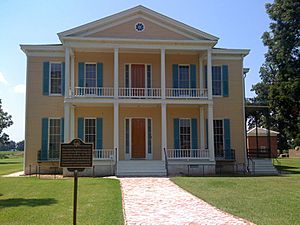
Arkansas played a key role in aiding Texas in its war for independence with Mexico, sending troops and materials to Texas to help fight the war. The proximity of the city of Washington to the Texas border involved the town in the Texas Revolution of 1835-36. Some evidence suggests Sam Houston and his compatriots planned the revolt in a tavern at Washington in 1834. When the fighting began a stream of volunteers from Arkansas and the eastern states flowed through the town toward the Texas battle fields.
When the Mexican-American War began in 1846, Washington became a rendezvous for volunteer troops. Governor Thomas S. Drew issued a proclamation calling on the state to furnish one regiment of cavalry and one battalion of infantry to join the United States Army. Ten companies of men assembled here where they were formed into the first Regiment of Arkansas Cavalry.
Civil War
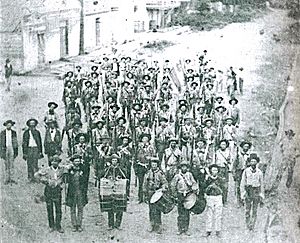
Arkansas refused to join the Confederate States of America until after United States President Abraham Lincoln called for troops to respond to the Confederate attack on Fort Sumter, South Carolina. The state was unwilling to fight against its neighbors and seceded from the Union on May 6, 1861. While the state was not a chief battleground, it was the site of numerous small-scale battles during the American Civil War. When Union forces captured Little Rock in 1863, the government relocated to the town of Washington in the southwest part of the state.
Natives of during the Civil War included Confederate Major General Patrick Cleburne. Considered by many to be one of the most brilliant Confederate division commanders of the war, Cleburne was often referred to as "The Stonewall of the West." Also of note was Major General Thomas C. Hindman. A former United States Representative, Hindman commanded Confederate forces at the battles of Cane Hill and Prairie Grove.
Late 19th century
Under the Military Reconstruction Act, Congress readmitted Arkansas in June 1868. With the right to suffrage, freedmen began to participate vigorously in the political life of the state. From 1869 to 1893, more than 45 African American men were elected to seats in the state legislature. As in other states, they were already leaders in their communities: often ministers or teachers, or literate men who had returned from the North. Some had both white and African-American ancestors.
In 1874, the Brooks-Baxter War shook Little Rock. The dispute about the legal governor of the state was settled when President Ulysses S. Grant ordered that Joseph Brooks to disperse his militant supporters.
In 1881, the Arkansas state legislature enacted a bill that adopted an official pronunciation for the state, to combat a controversy then raging.
During the late 1880s and 1890s, the Democrats worked to consolidate their power and prevent alliances among African Americans and poor whites in the years of agricultural depression. They were facing competition from the Populist and other third parties. In 1891, state legislators passed a statute requiring a literacy test for voter registration, when more than 25% of the population could not read or write. In 1892 the state passed a constitutional amendment that imposed a poll tax and associated residency requirements for voting, which combined barriers sharply reduced the numbers of blacks and poor whites on the voter rolls, and voter participation dropped sharply.
Having consolidated power among its supporters, by 1900 the state Democratic Party began relying on all-white primaries at the county and state level. This was one more door closed against blacks, as the primaries had become the only competitive political contests; the Democratic Party primary winner was always elected. In 1900 African Americans numbered 366,984 in the state and made up 28% of the population - together with poor whites, more than one-third of the citizens were disfranchised. Since they could not vote, they could not serve on juries, which were limited to voters. They were shut out of the political process.
20th century
Great Migration
The growth in industrial jobs in the North and Midwest attracted many blacks from the South in the first half of the 20th century. Their migration out of the South was a reach toward a better quality of life where they could vote and live more fully as citizens. Agricultural changes also meant that farm workers were not needed in as great number. Thousands left Arkansas. During the years of World War II, blacks also migrated to California, where good jobs were expanding in defense industries.
Civil rights movement
In one of the first major cases of the African-American civil rights era, the Supreme Court ruled in Brown v. Topeka Board of Education (1954) that segregated schools were unconstitutional. Both of Arkansas' U.S. Senators (J. William Fulbright and John L. McClellan) and all six of its U.S. Representatives were among those who signed the Southern Manifesto in response.
The Little Rock Nine incident of 1957 centered around Little Rock Central High School brought Arkansas to national attention. After the Little Rock School Board had voted to begin carrying out desegregation in compliance with the law, segregationist protesters physically blocked nine black students recruited by the NAACP from entering the school. Governor Orval Faubus deployed the Arkansas National Guard to support the segregationists, and only backed down after Judge Ronald Davies of U.S. District Court for the Eastern District of Arkansas granted an injunction from the U.S. Department of Justice compelling him to withdraw the Guard.
White mobs began to riot when the nine black students began attending school. President Dwight D. Eisenhower, on the request of Little Rock Mayor, deployed the 101st Airborne Division to Little Rock and federalized the Arkansas National Guard to protect the students and ensure their safe passed to school. Little Rock's four public high schools were closed in September 1958, only reopening a year later. Integration across all grades was finally achieved in fall 1972.
Bill Clinton
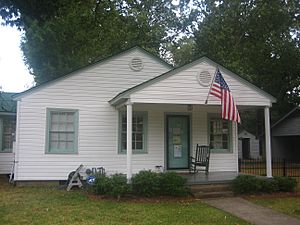
Bill Clinton, born in Hope, Arkansas, served nearly twelve years as the 40th and 42nd Arkansas governor before being elected 42nd president in the 1992 election. He was reelected to the Presidency in 1996 and served until January 2001.
Changing racial attitudes and growth in jobs have created a New Great Migration of African Americans back to metropolitan areas in the developing South, especially to such states as Georgia, North Carolina and Texas. These have developed many knowledge industry jobs.
Images for kids
-
A map of the region in Louisiana, 1687
-
Colbert's raid on Arkansas Post in 1783
-
The United States, with the Louisiana Purchase overlaid
-
Map of the United States showing Arkansaw Territory, 1820
-
The Indian Removal Act resulted in the transplantation of several Native American tribes and the Trail of Tears.
-
The Turning of the Tune: Traveller Playing the "Arkansas Traveller", lithograph by Currier and Ives, 1870
-
Battle of Pea Ridge in March 1862
-
Price's Missouri Raid in the fall of 1864
-
A drawing of U.S. Colored Troops mustered out at Little Rock, 1866.
-
Anthony House – Scene of the 1874 conflict between Brooks and Baxter.
-
University of Arkansas, founded by the General Assembly in 1868, is one of many public universities in the state.
-
Wife and children of a sharecropper in Washington County, Arkansas, c. 1935
-
Man with child at a meeting of the Southern Tenant Farmers Union, 1937
-
Time magazine (October 7, 1957), featuring paratroopers at Little Rock.
See also
 In Spanish: Historia de Arkansas para niños
In Spanish: Historia de Arkansas para niños


